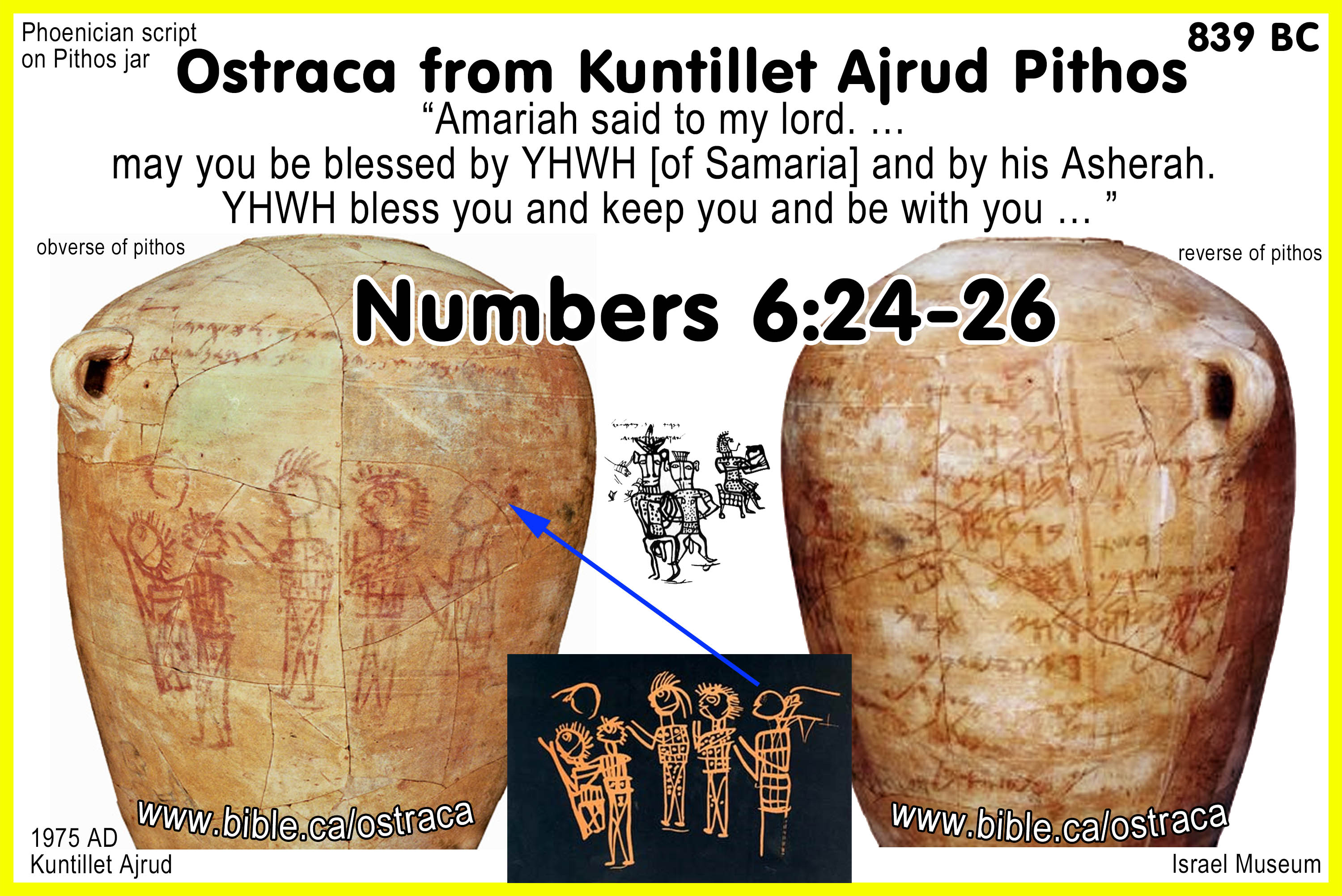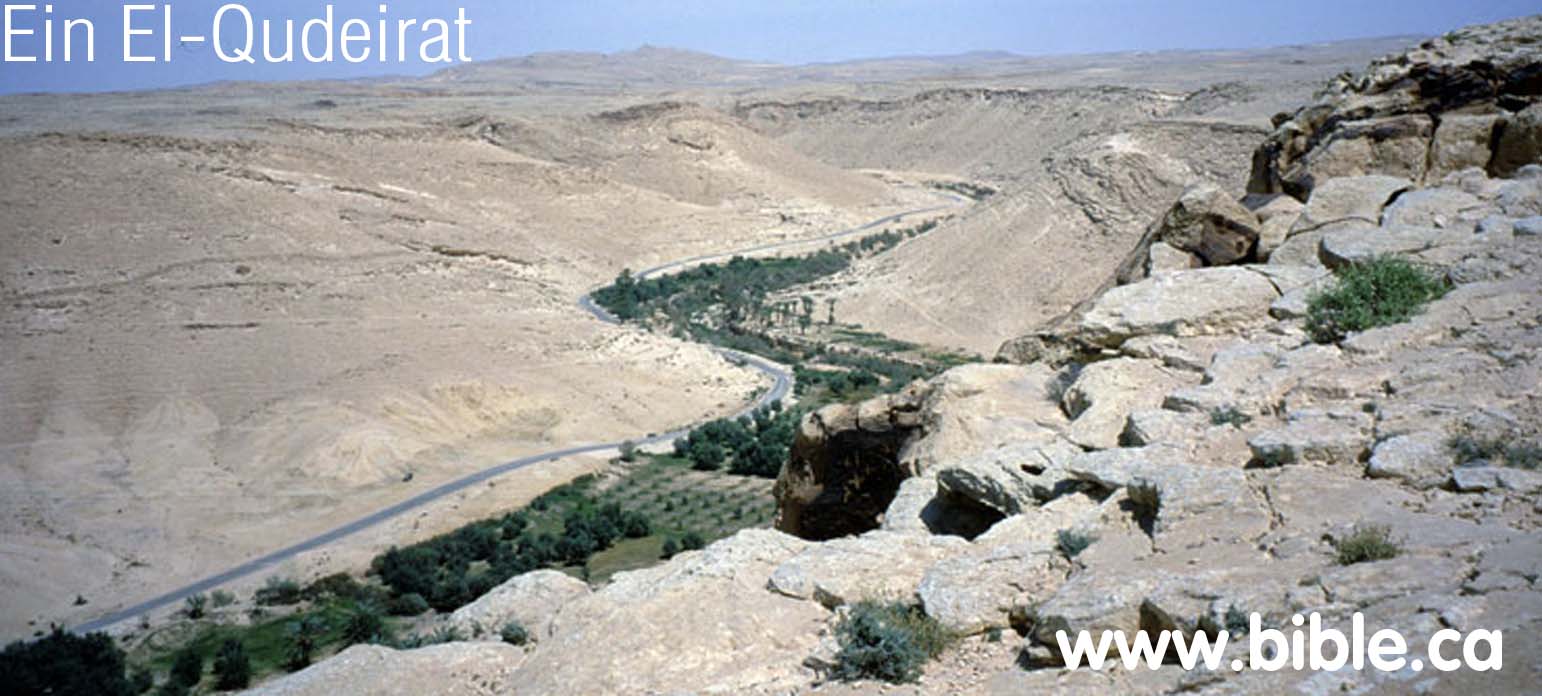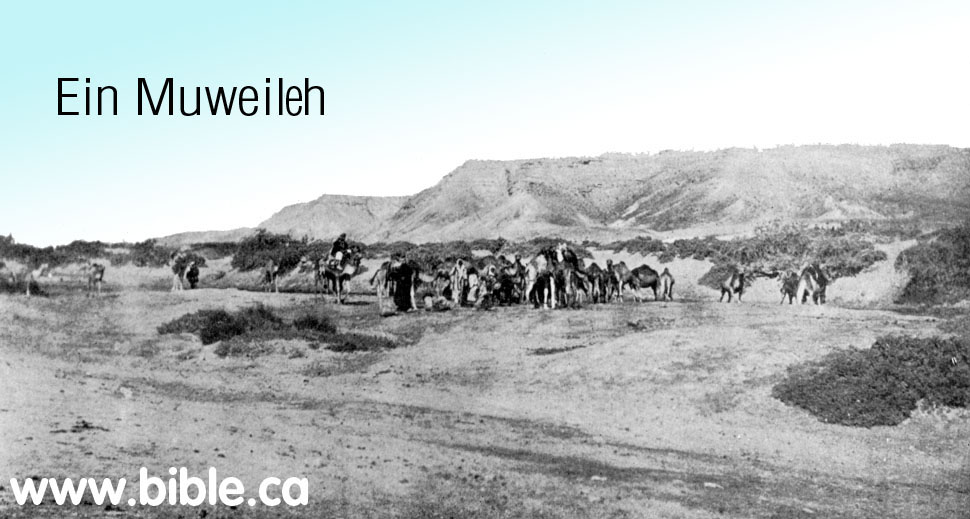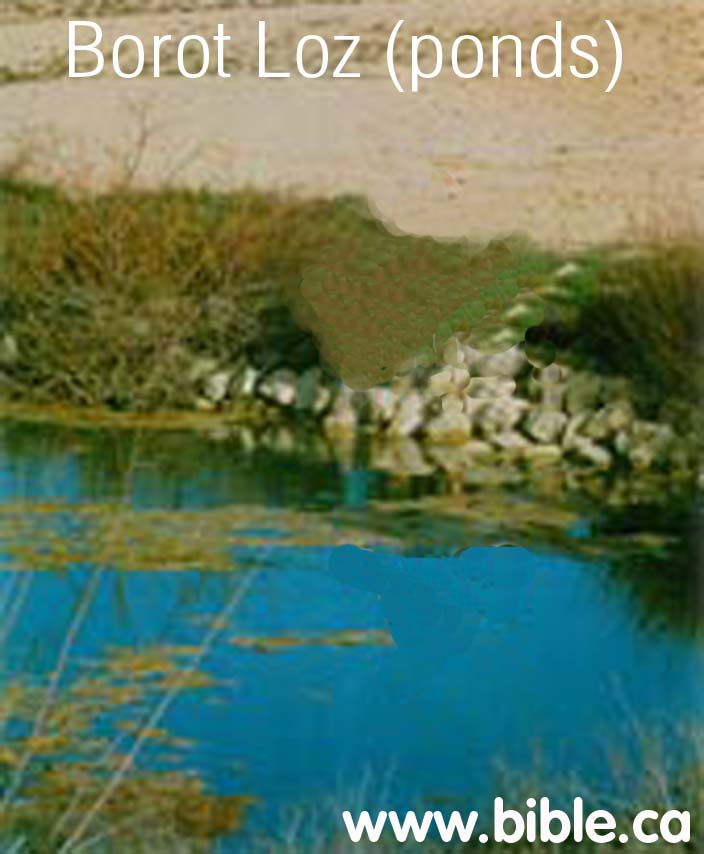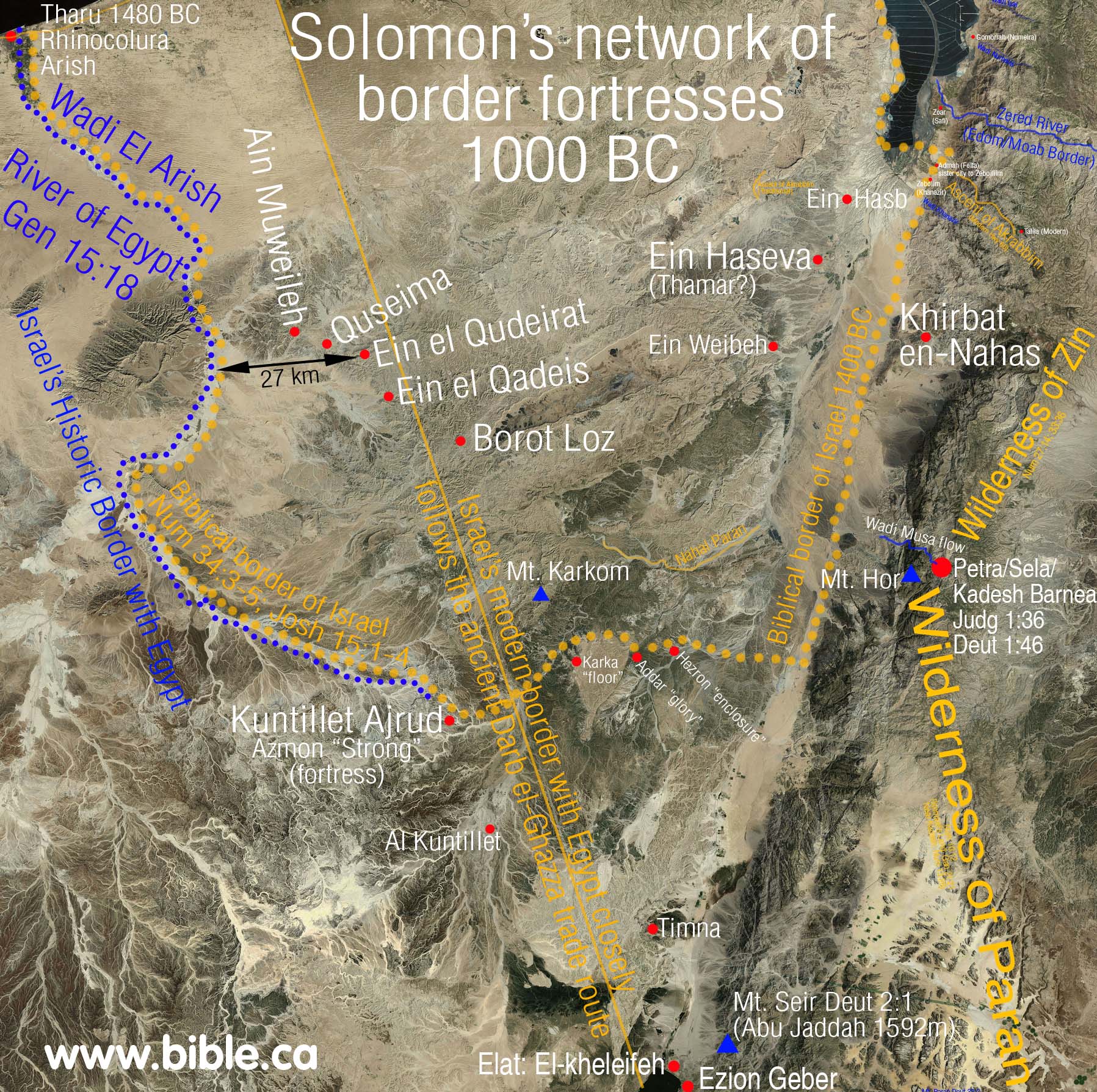Kuntillet Ajrud Fortress and
Ostraca on Pithos Jar:
(Possibly one of
Solomon's network of military border fortresses)
|
|
||||||
|
Introduction document: Solomon's network of military border fortresses |
||||||
|
|
||||||
Introduction:
- Dating Kuntillet Ajrud: It may be as early as Solomonic (950 BC) or as late as Israeli (Samaria period, 830-775 BC)
- OLDEST BIBLE TEXT ON EARTH: Numbers 6:24-26
a. Kuntillet Ajrud is probably most famous for the inscription found there that indicates a period of mixing paganism with pure monotheistic Judaism: "Amaryau said to my lord. ... may you be blessed by Yahweh and by his Asherah. Yahweh bless you and keep you and be with you".
b. Founded as a Negev border fortress by Solomon, it was occupied by the pagan Jews from the corrupt northern tribes whose capital was Samaria.
c. Notice that they are Jews worshipping YHWH, but then say that YHWH has a wife! (Consort or Asherah).
d. Most striking is that this pagan inscription contains the oldest quotation of the Bible on earth from Numbers 6:24-26 “may the Lord bless and keep you”.
e. Although the text is in Phoenician, it predates the famous silver scroll by 140 years! (See details about the Silver Scroll from Ketef Hinnom)
f. The Phoenician inscription is not a direct match for the Torah words in Numbers 6:24, but it is clearly a paraphrase.
- "The Arabic name, meaning "hill of the water-source," of a site located in N Sinai. (Kuntillet Ajrud, Ze'ev Meshel, Anchor Bible Dictionary, 1991 AD).
- Several anomalies that make Kuntillet Ajrud unique include:
- no Negevite war pottery has been found to date.
- Unusual benches retrofitted inside the triple gate of the original fortress as a second use as a waiting room of some kind before gaining entrance. The secondary purpose of this structure is a mystery and some have concluded it was a spiritual rest stop type of place, but not an actual temple of worship per se.
- The strategic location of Kuntillet Ajrud is located 15 km west of the ancient Darb el-Ghazza.
- Solomon chose to set it west of the trade route to further ensure it would be protected.
- While it is true that no fortresses have been found directly on the Darb Ghazza trade route, several have found on either side like Kuntillet Ajrud and Borot Loz ponds. "And above all, south of Qadesh Barnea along important Darb Ghazza, the main route to the Gulf of Eilat, not even one fortress has been found" ("Aharoni Fortress" near Quseima, Zeev Meshel, 1994 AD)
A. Date of the fortress at Kuntillet Ajrud: 950 BC or 830-775 BC
1. Archeologist Cohen, who excavated Qudeirat dated Kuntillet Ajrud to the 10th century BC.
a. Cohen dates the three successive structures from the time of Solomon.
b. The date for Kuntillet Ajrud is the 10th century BC by Cohen.
c. It has all the basic ear marks of a fortress with many similarities with, including the corner tower structures.
d. Cohen believed Kuntillet Ajrud had three continuous periods of occupation by a centralized government under the direction of several kings of Judah beginning with Solomon.
e. Secondary use of a fortress structure build by Solomon at the end of the 8th century BC is still a possibility.
2. One of the problems in the dating, is that those who date the site later are known reductionists, ie they view the monarchy of David and Solomon as a myth.
a. It is important to keep this in mind because future excavations and further examinations of the pottery by biblical conservative archeologists may one day confirm Cohen’s original dating of the site to the time of Solomon.
b. Reductionists Finkelstein and Ussishkin, both of whom view “David and Solomon as another Bible myth”, reject Cohen's view that this was built by Solomon and therefore date the structure to the 9th century or later.
c. Having said this, we must take into careful consideration the facts and details because their dating of the site to the last days of Elisha may be correct.
3. In support of a date for Kuntillet Ajrud of 830-775 BC or even later:
a. It is tantalizing to try to date Kuntillet Ajrud, to pinpoint in whose reign this religious center was established. The pottery and the form of the script suggests the end of the 9th to the beginning of the 8th centuries. (Did Yahweh Have a Consort, Kuntillet Ajrud, Ze'ev Meshel, 1979 AD)
b. The date of the site, determined by typological and paleographic analysis, and by the need to identify an historical period in which N Israelite influence over Judah was especially strong, points to the period after the death of Jehoshaphat of Judah (ca. 850 B.C.E.). The reigns of Jehoram, Ahaziah, and Athaliah (between 850 and 837 B.C.E.) seem distinct possibilities. However, the period of Joash king of Israel (ca. 801-786 B.C.E.), who captured Amaziah king of Judah, broke down the wall of Jerusalem, and seized the treasures of the Jerusalem temple and palace (2 Kgs 14:1-16 = 2 Chr 25:1-24) seems especially well suited. This would be reinforced if the reconstruction of on the top line of the Bes figurine inscription indeed is a reference to Joash. It may tentatively be suggested that Joash intended to gain direct access to the Red Sea, and that this was the reason for the war between the two kings. The victory of Joash is reflected in the construction of the buildings at Kuntillet Ajrud, and accounts for the concurrent references to the "Yahweh of Samaria" and the "Yahweh of Teman"; i.e., Samaria's god (as well as its king) having dominion over the entire region through which one reached "Teman" (meaning "the far south"). (Kuntillet Ajrud, Ze'ev Meshel, Anchor Bible Dictionary, 1991 AD)
c. "The enclosure of Kuntillet Ajrud, excavated by Z. Meshel, is an unusual site, whose nature and function are far from clear. Although it is located in southern Sinai, the finds from the enclosure indicate strong cultural connections with the kingdoms of Israel and Judah. The route and means of these connections are of great importance. Kuntillet Ajrud is located c. 50 km. south-west of Kadesh-Barnea; hence the assumption that Kadesh-Barnea served as a central station along the route from Israel and Judah to Kuntillet 'Ajrud. According to Meshel, Kadesh-Barnea was a station along Darb el-Ghaza, the road to Eilat which passed in the vicinity of Kuntillet 'Ajrud. Cohen's conclusion that the excavations at Kadesh-Barnea attest to settlement continuity from the 10th to the 5-4th centuries B.C.E. forms the background to the above view. According to Cohen, it included three successive governmental fortresses built by the kings of Judah. If that is so, Kadesh-Barnea must have been a central station on the long route from Israel and Judah to Kuntillet 'Ajrud. The opposite, however, seems to be true. Scholars agree that the enclosure of Kuntillet 'Ajrud is a single period site dating from the end of the ninth or the beginning of the eighth century B.C.E. During this period the site of Kadesh-Barnea was abandoned (E. Ayalon, who studied the pottery assemblage of Kuntillet `Ajrud, emphasized the absence there of the pottery assemblages characterizing Kadesh-Barnea22). Hence Kadesh-Barnea and its fortress were not a factor in developing connections between Israel and Judah and Kuntillet 'Ajrud beyond the fact that Kadesh-Barnea formed an oasis along the desert route. This strengthens the conclusion that Kuntillet 'Ajrud was a unique place, and is a factor that should be taken into account when the character and function of the site are being evaluated." (The Rectangular Fortress at Kadesh Barnea, David Ussishkin, 1995 AD)
4. More recent examinations of both Carbon 14 and pottery reading have dated the site to the period of 830-775 BC.
B. The structure, finds a lack of Negev ware pottery found:
More on Negev Pottery.
- "The Western Structure. The walls of structure A are at points preserved to a height of 1.5 meters. The building itself extends over an area of approximately 15 x 25 meters. It is rectangular, with four corner rooms protruding outward (resembling "towers") and with indirect entry from a small eastern vestibule. The plan initially seems to resemble a small fortress, similar in appearance to the Israelite citadel-with-towers found at Kadesh-barnea, Arad, and `Uza. Structure A differs, however, in a number of important respects: it lacks the casemate walls typical of these fortresses, and its remains are unusual for a fortress and suggest a different type of function altogether." (Kuntillet Ajrud, Ze'ev Meshel, Anchor Bible Dictionary, 1991 AD)
- "From the court area, one entered the main structure proper by first passing through a small gate room (locus 5), turning left into a narrow room divided into two wings, whose walls were surrounded by plastered stone benches. This "bench room" (locus 6) extends N-S across the entire width of the building and apparently was the most important part of the site. The plastered stone benches take up most of the area, with only a narrow passage remaining between them, suggesting that the main function of the room is to be associated with the benches, not the passage-way. An additional function is suggested by the manner in which the wings of the bench room are connected to the two corner rooms at their respective ends (loci 7 and 13). These have no usual doorway but instead are connected to the bench room by very narrow "windows" whose sills are formed by the lateral benches themselves. By examining these benches it became clear that they had been constructed in a second phase, thus partially blocking the small openings that were present in the first phase of the building. Apparently these openings were merely structural features serving no other purposes, and the first phase was merely the stage of the building's construction." (Kuntillet Ajrud, Ze'ev Meshel, Anchor Bible Dictionary, 1991 AD)
- What is
clear from the drawing below, is that sections 1,2,3 are part of a gate
system for the fortress. In time the security of the fortress was no
longer an issue and the inner gate section became a waiting area so the
benches were installed, as Meshel indicates, as a secondary use of the
structure.

- Ruins of the site date to the 8th century B.C. (the time of the Israelite monarchy), and various remains suggest that it served as some sort of a religious center. Of particular significance are inscriptional references to "Yah-weh of Samaria and his Asherah" and to "Yahweh of Teman," which provide important evidence of the complex nature of Israelite religion during the OT period." (Kuntillet Ajrud, Ze'ev Meshel, Anchor Bible Dictionary, 1991 AD)
- Although it seems unlikely, it is furthermore possible that the two structures were not contemporaneous and that the E structure slightly preceded the W one. (Kuntillet Ajrud, Ze'ev Meshel, Anchor Bible Dictionary, 1991 AD)
- Because the site was occupied for a relatively brief time span, the large mass of pottery discovered there presents interesting analysis. If the site indeed can be dated to ca. 800 B.C.E., then the pottery corpus from Kuntillet Ajrud could serve as an important comparative standard for identifying contemporaneous levels at other sites. (Kuntillet Ajrud, Ze'ev Meshel, Anchor Bible Dictionary, 1991 AD)
- Surprisingly, the site yielded no "Negeb-type pottery" supposedly associated with the no-madic inhabitants of the area. (Kuntillet Ajrud, Ze'ev Meshel, Anchor Bible Dictionary, 1991 AD)
- Textile Remains. Kuntillet Ajrtid is unique in that it yields textile remains from the period of the Israelite monarchy. About one hundred cloth fragments, almost all of linen (only seven of wool) were discovered among the ruins. A. Sheffer (1978) details the superior quality of the threads and the unique characteristics of the fabrics. It has been noted that, in violation of biblical law (Lev 19:9; Deut 22:9-11), some of these fabrics were made by combining wool and linen (on one piece red woolen threads were interwoven with blue linen ones.) (Kuntillet Ajrud, Ze'ev Meshel, Anchor Bible Dictionary, 1991 AD)
- But since Palmer's day archaeologists have learned a great deal about pottery dating. After the 1967 Six-Day War we came to the site and by examining the sherds which lay strewn about we were able to detect Palmer's error easily and to date the site to Iron Age II or the Israelite period. This new date identified the site as the southernmost outpost of the Judean kingdom, and it became a prime candidate for excavation. (Did Yahweh Have a Consort, Kuntillet Ajrud, Ze'ev Meshel, 1979 AD)
- The top of the hill comprising the site is an oblong plateau extending east-west, with the ruins located at its western end. Wells in the vicinity in use even today gave the site its ancient importance. The modern Arabic name Kuntillet Ajrud means "Solitary Hill of the Wells," a name which accurately reflects its character. The site contains the remains of only two structures: a main building at the western extremity of the plateau and a smaller building east of it (see plan). The two buildings are in very different states of preservation. Almost nothing is left of the small building on the east, and there is little to say of it. The main building, whose walls have survived to a height of five feet, measures approximately 75 × 45 feet, and takes up the whole width of the narrow plateau. (Did Yahweh Have a Consort, Kuntillet Ajrud, Ze'ev Meshel, 1979 AD)
- Tower-like corner rooms (11 and 12) were found in the western corners of the building. (Did Yahweh Have a Consort, Kuntillet Ajrud, Ze'ev Meshel, 1979 AD)
- The relatively well-preserved condition of these tower-like rooms revealed some interesting construction details: (Did Yahweh Have a Consort, Kuntillet Ajrud, Ze'ev Meshel, 1979 AD)
- The vessels from Masada date about 800 years later than the storage jars at Kuntillet Ajrud and the Mishna is still later, but perhaps the tradition recorded in the Mishna and preserved at Masada is based on a custom already prevalent in the days of the Monarchy. (Did Yahweh Have a Consort, Kuntillet Ajrud, Ze'ev Meshel, 1979 AD)
- Additional support for the hypothesis of a group of priests living at Kuntillet Ajrud is the large quantity of finely woven linen fabric found there. (Did Yahweh Have a Consort, Kuntillet Ajrud, Ze'ev Meshel, 1979 AD)
C. Strategic Location:
- "Kuntillet Atrild is located approximately 50 km south of Kadesh-barnea and about 15 km W of Darb el-Ghazza, a road which since antiquity has run N-S, connecting Quseima and Kadesh-barnea to Elat and S Sinai. The isolated hill rises prominently from the broad valley of Wadi Quraiya (or "wadi of the small building"), which forms a natural W-E route. See Fig. KUN.01. The top of the hill is a long and narrow plateau, and the actual ruins are found at its W end. At the foot of the hill there is a concentration of shallow wells providing one of the few reliable sources of water in this arid and isolated area. These wells made this site an important crossroads in the past—a fact also recorded on old maps of the modern period. The combination of water and crossroads undoubtedly contributed to the selection of the site for a small settlement." (Kuntillet Ajrud, Ze'ev Meshel, Anchor Bible Dictionary, 1991 AD)
- Kuntillet Ajrud is located about forty miles south of Kadesh-Barnea and sits on a hill which rises beside the Wadi Quraiyaa. Old maps reveal that the site is a crossroads of desert tracks: one leads from Gaza through Kadesh-Barnea to Eilat; another traverses the Sinai along the Wadi Quraiya; and a third branches off to the south via Temed, a well-known way station in later times, to the center of southern Sinai. (Did Yahweh Have a Consort, Kuntillet Ajrud, Ze'ev Meshel, 1979 AD)
D. Many Ostraca: The inscriptions found at Kuntillet Ajrud: Religious center:
1. Many ostraca were found at Kuntillet Ajrud, including pithos jars that were reconstructed.
2. About the ostraca found at Kuntillet Ajrud:
a. In 1975-76 several Hebrew and Phoenician inscriptions were discovered in a fortress-like structure at Kuntillet Ajrud (Kuntillet Quraiyah) in the northern Sinai. (A Note on an Inscription from Kuntillet Ajrud, Debra A. Chase, 1982 AD)
b. The unusual finds (especially the inscriptions and pictures) testify to the- uniqueness of the site. The subject matter of the inscriptions, the references to various deities, and the presence of dedicated vessels all suggest that Kuntillet Ajrad was a religious center; however, the lack of things usually associated with ritual sacrifice (e.g., altars) and the architectural layout of the site indicate that the remains are not those of a temple. It appears that the site may have served as a "wayside shrine" that, due to its location, was associated with journeys of the Israelite kings to Elat and to Ezion-geber, and perhaps also with the travels of pilgrims to S Sinai. These were able to journey S along the Darb el-Ghazza from Kadesh-barnea, stopping at the place to make dedications to Israel's god in the bench room of the main building. The strong N (Israelite, not Judean) influence in the remains seems to connect Kuntillet Ajrud with the N kingdom of Israel or with one of the Judean kings closely aligned with the N kingdom of Israel. This N influence is evident in the reference to "Yahweh of Samaria," in the Phoenician-style writing, in the cosmopolitan style and motifs of the decorative and pictorial artwork, in the pottery types, and in the onomastic conventions (names ending in -yau, and not -yahu). The site, occupied for only a few years, was likely inhabited by a small group of priests dispatched from the N kingdom of Israel with an officer at their head. They were sustained by the various sacrifices and tithes that were sent as provisions primarily from Judah; in return, they rendered their cultic services to travelers. (Kuntillet Ajrud, Ze'ev Meshel, Anchor Bible Dictionary, 1991 AD)
c. When the inscriptions were read, we discovered that they provided clear evidence that Kuntillet Ajrud was not merely a resting place for desert travelers but was principally a religious center. (Did Yahweh Have a Consort, Kuntillet Ajrud, Ze'ev Meshel, 1979 AD)
d. It would be tempting to call the building at Kuntillet Ajrud a temple, but it bears none of the architectural features we customarily associate with a temple. The plan of the building does not contain a holy of holies, nor does it conform to the plan of other temples known from excavations in the Near East. Moreover, we found the remains of no cult objects, such as animal altars or incense burners or cult altars. (Did Yahweh Have a Consort, Kuntillet Ajrud, Ze'ev Meshel, 1979 AD)
e. On the other hand, although the building was probably not a temple, we think that it was a religious center of some kind where people deposited their offerings in the bench-room. (Did Yahweh Have a Consort, Kuntillet Ajrud, Ze'ev Meshel, 1979 AD)
f. The site represents, in our opinion, a religious center which had some connection with the journeys of the Judaean kings to Eilat, Ezion-Geber and perhaps even to southern Sinai. The establishment of this center may have come about through identification of the site with one of the Israelite traditions concerning Sinai.
3. Translations of the many ostraca found at Kuntillet Ajrud:
a. OLDEST TEXT OF THE BIBLE ON EARTH: Phoenician inscription on Pithos Jar: “Amariah said to my lord. … may you be blessed by YHWH [of Samaria] and by his Asherah. YHWH bless you and keep you and be with you … ”
i. Notice how the above inscription is very close to the Priestly benediction of Numbers 6:24-26: "The LORD bless you, and keep you; The LORD make His face shine on you, And be gracious to you; The LORD lift up His countenance on you, And give you peace.’" (Numbers 6:24–26)
ii. Most striking is that this pagan inscription contains the oldest quotation of the Bible on earth from Numbers 6:24-26 “may the Lord bless and keep you”. Although the text is in Phoenician, it predates the famous silver scroll by 130 years!
iiI. The fact the words in the inscription are different than the Hebrew words found in Numbers 6:24, do not change the fact that it was a paraphrase of this most famous Priestly benediction that was widely used.
iV.
See details about the Silver
Scroll from Ketef Hinnom
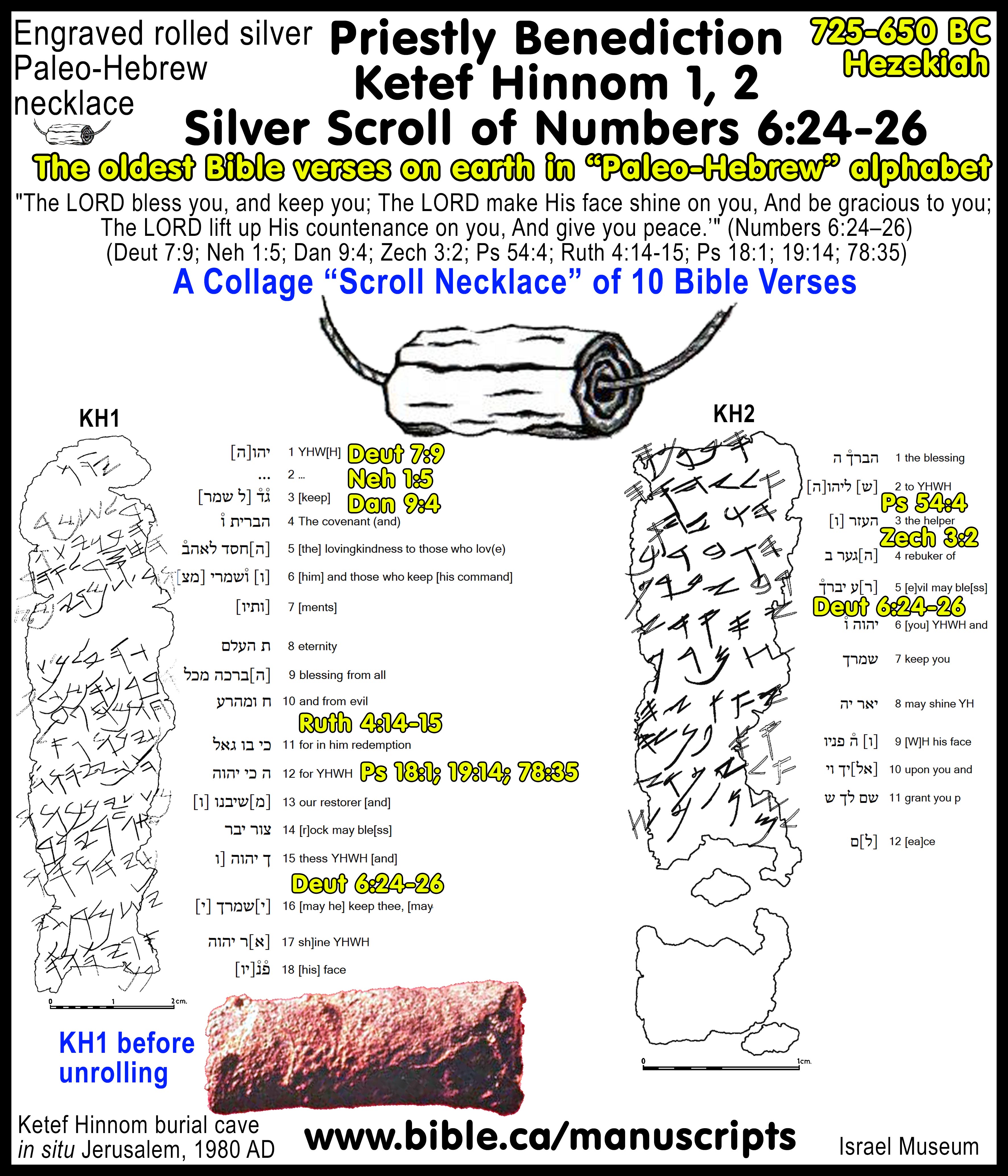
b. Pithos Jar inscription: “Utterance of ʾAshyaw the king: “Say to Yehallel and to Yawʿasah and to […]: ‘I bless you by Yahweh of Samaria and his asherah!”
c. Door lentil inscription: “and in the (just) ways of El” … “blessed be Ba’al in the day of … ” … “the name of El in the day of … ”
i. Notice the connection with the Law of Moses and the location where this inscription was found in situ in the door lentil.
ii. “You shall write them on the doorposts of your house and on your gates." (Deuteronomy 6:9)
d.
10th century BC (time of Solomon) Bowl Rim inscription:
“(Belonging) to ‘Obadyau son of ‘Adnah, may he be blessed by Yahwe(h) …”
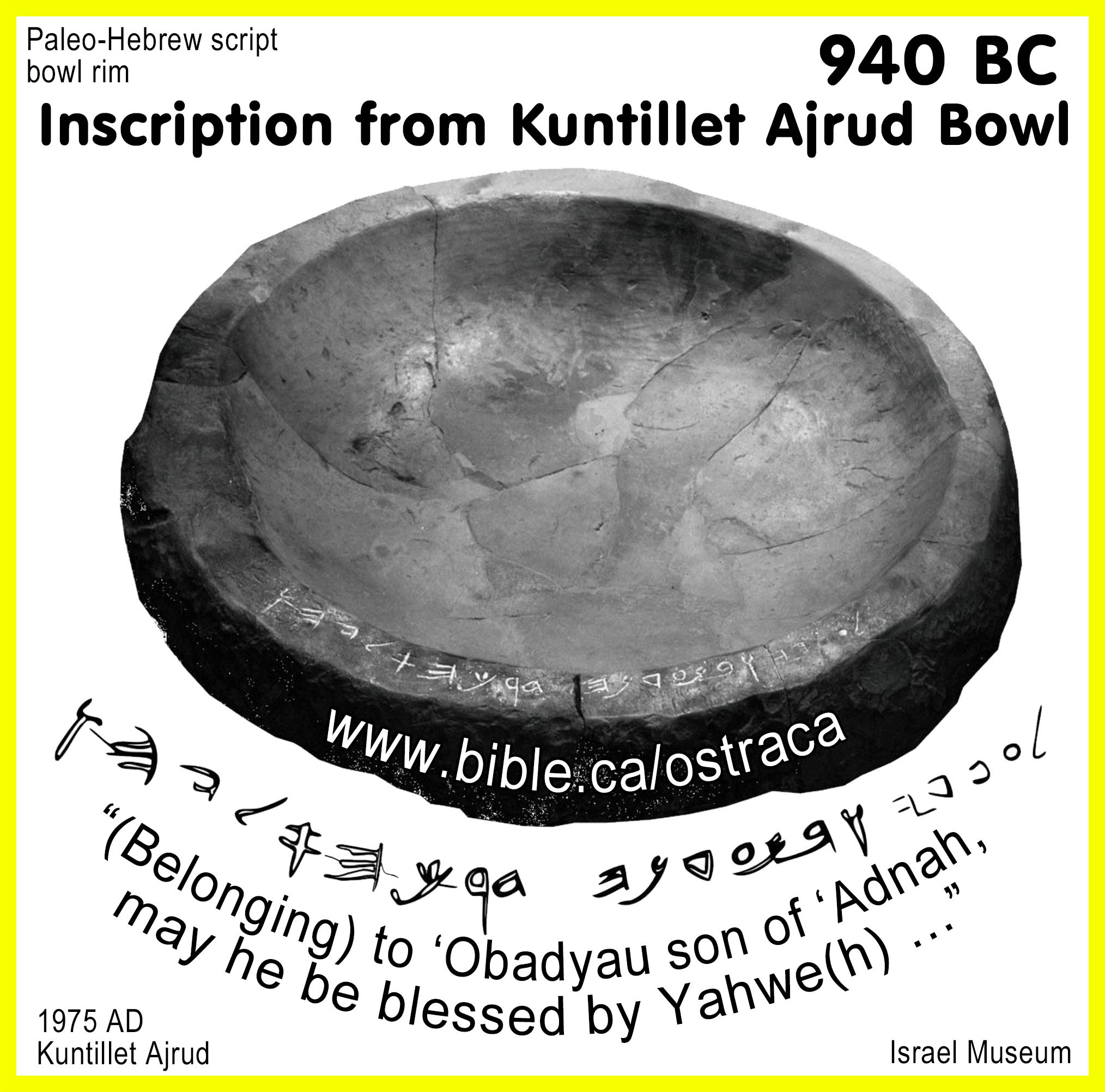
Conclusion:
1. The weight of archeological evidence for Kuntillet Ajrud points to a single occupation site by the northern kingdom of Israel, dating to 830-775 BC.
a. The emphasis of YHWH of Samaria (the capital city of the 10 northern tribes) is important because the site is located deep inside the southern Judean kingdom.
b. The mix of paganism and YHWH worship is characteristic of both Israel and Judah during the period.
c. The reforms to stamp out idolatry by Asa king of Judah and Jehu king of Israel, were as quickly forgotten as the latter reforms of Josiah.
d. We can point to the very dominant reign of king Jehu of Israel during the weak during the tumultuous reign of Queen Athaliah of Judah fit a date of 830-775 BC perfectly.
2. Regardless of whether or not it was founded as a border fortress by Solomon around 950 BC, all agree that the many ostraca do date from the period of 830-775 BC.
3. The oldest text of the Bible every excavated is found on one of the pithos jars. While it is in Phoenician script, not Paleo-Hebrew and while it uses different words than in the Torah, it is clearly a paraphrase of this most famous “priestly benediction” (Num 6:24f) also seen in the Silver Scroll that dates 130 years later.
By Steve Rudd: Contact the author for comments, input or corrections.
